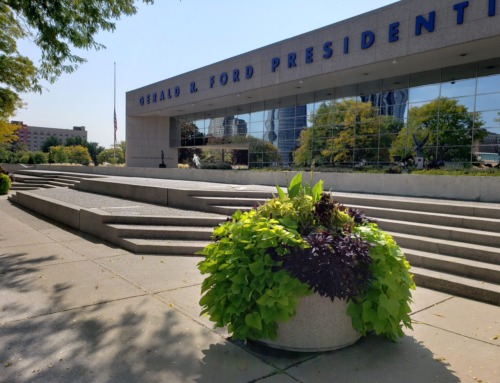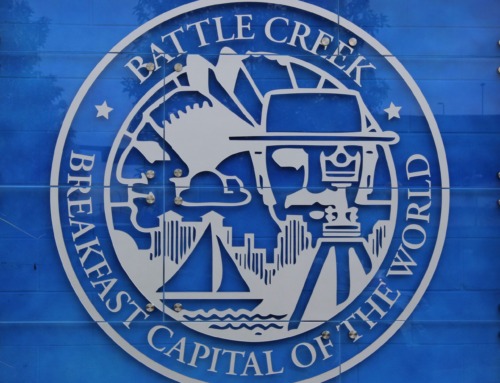If you live in Michigan, or anywhere else in the Midwest for that matter, you’ve likely tasted a Vernors Ginger Ale. It is considered Michigan’s #1 cold medicine and is great when heated and mixed with lemon juice for sore throats and coughs. It is also known to cure the occasional queasy stomach. The inventor of this tasty product was James Vernor from Detroit, Michigan.
James Vernor’s Early Years
James Vernor was born in Albany, New York to John Taylor Vernor, a bookkeeper from a wealthy family, and Polly Smith Vernor on April 11, 1843. He was the youngest of seven children. When he was around the age of five, the family moved to Detroit, via the new Erie Canal. He held a few menial jobs, then in 1858, at the age of fifteen, James started a job as an errand boy for the Higby & Stearns Drug Store in Detroit.
Young James was known as a spirited and enthusiastic employee, good at parcel wrapping and making fast deliveries. He quickly made his way up to the position of junior clerk. He even began experimenting with ginger ale on his own time hoping to find a more palatable flavor. Ginger ale, at the time, was being used as a medicinal tonic to calm the stomach, but ale was actually a type of beer. James was attempting to add vanilla and other spices to the ginger mixture to make it more palatable. Alas, his experiments were put on hold.
The Civil War Facts and Fiction
James left his position at the drugstore to serve in the Civil War in July of 1862. He joined the 4th Michigan Cavalry as a Union Army Hospital Steward. With his pharmacy experience he could assist with the soldier’s illnesses and wounds. He rose to the rank of Second Lieutenant and was given command of Brigade Company M in 1864. He and his unit fought at Murfreesboro, Stones River, Shelbyville, Reed’s Bridge, Chickamauga, Noonday Creek, Atlanta, Kilpatrick Raid, and Selma. They were even involved in the taking of Macon, Georgia. The regiment went down in history as the group that captured Jefferson Davis on May 10, 1865. Vernor himself wasn’t involved in the capture, as he had been captured himself shortly beforehand.
The most famous rumor of how the company got its start is that when Vernor left for the war, he left his last mixture of ginger ale in an oak barrel. When he returned to Detroit 4 years later, he opened the barrel and was surprised by the flavor of the contents. He found a zesty, sweet ginger flavor that was accentuated by the oak aging process. He called his concoction “deliciously different,” which would be a slogan for the future. This claim was later disputed by his son, James Vernor II, after his death but we may truly never know. However, the motto stuck and the story went down in history.
Vernor Starts His Business
In 1866, Vernor left his position with Higby and Stearns and opened a pharmacy with Charles L’Hommedieu. Vernor was known for being meticulous about his pharmaceutical work and guaranteeing quality, and accuracy, as well as preventing possible drug interactions. He had very high standards for everything he did. At this time, many pharmacists were developing new tonics that promised to cure just about everything. James was no different, as he continued working on his own invention. Later that year, Vernor’s Ginger Ale was first served to the public.
For years, Vernor’s pharmacy had the only soda fountain where you could buy his particular drink, but as its popularity and demand grew, Vernor began to sell his product to other establishments. Soon, every first-class drugstore installed the equipment required by Vernor to properly serve his beverage. Wherever Vernor’s Ginger Ale was sold, he included a brochure with specific instructions for the distributors that included the demand that not a single glass should ever be sold at a temperature above 45 degrees.
James married Emily Walker Smith, daughter of English immigrants, in 1873. On March 25, 1877, she gave birth to their first and only son, James II in Detroit. Later in 1880, their daughter, Emily Louise was born. By this time, James had bought out his partner and the business was solid. Just as in his pharmaceutical work, Vernor was known to be very detail-oriented and vigilant about the carbonated water for his drink. He wanted to make sure everything was of the same consistency. The water had to be specially purified. The blending needed the finest Jamaican Ginger, distilled in absolute proper proportion with the other fruit juices. It didn’t take long before the drink became available across the Midwest.
Vernor Becomes a Quality Activist
After noticing that some pharmacists were selling medicine whose effects were unproven, or even worse, harmful, Vernor sought change. He helped establish industry regulations by forming the Michigan Board of Pharmacy in 1887. He would operate his business under the board’s first license, making him the state’s first licensed pharmacist.
In 1888, Vernor decided to enter politics as a member of the Michigan Republican Party. His interest in city affairs likely started as a response to the frequent flooding of his basement and those of his neighboring businesses because of an inadequate city sewer system. He was elected to be an alderman in Detroit, an early version of the city council. His role in the passage of sewerage laws would help Detroit become a business hub.
Vernor served on the city council for 25 years. He advocated for the city railway system and then helped create it. This replaced the many horse-drawn carriages in the city. He also advised for the private ownership of the transportation system, as he believed that public ownership would create corruption and would be less efficient. He squared off against the current mayor of Detroit (and future Michigan governor) Hazen Pingree on the issue. This caused a lot of discord between the two of them. Vernor was not opposed to raising taxes for a reasonable cause such as education or improvement to infrastructure, but felt transportation should remain private.
Bottling Vernors Ginger Ale
In 1896, James and James II closed the drugstore and opened a soda fountain on Woodward Avenue, near the riverfront ferry docks. They organized a manufacturing plant and focused their goals on the ginger ale business. This plant was devoted to the blending, aging, and bottling of Vernor’s Ginger Ale. They also purchased a horse named Dick and a light wagon to help them with the distribution. The popularity of the beverage continued to grow and customers could even order kegs of it for home parties.
At first, the father and son duo were the only employees. They worked sixteen hours a day, washing bottles, making and bottling ginger ale, delivering it to various sites in the city, and taking care of all clerical duties. There was some local competition from Dr. Kronk’s sarsaparilla-favored drink and America’s Favorite Ginger Ale in Dayton Ohio, but Vernor’s prevailed over both of these companies.
In 1898, James Vernor II became president of the company and his strong leadership helped the company to flourish while allowing James to pursue other interests. In 1915, they expanded operations to include a bottling company. This was also the year that Vernor made a political decision that was motivated by his own self-interest. A proposal came before the council to build a municipal ferry service to Belle Isle and Windsor, Canada. While he was not completely opposed to a ferry, he did not like that the terminal would be on First Street, which would have taken all the foot traffic away from his retail store. He was able to use his influence to kill the proposal.
Vernor’s Legacy Lives On
In 1918, the Riverside Power Plant was purchased and converted to fit the needs of the Vernor business. A year later, they erected a 6-story main building, adjacent to the existing building. The latest Vernor plant was a block long and had glass windows showing the bottling process and an iconic sign that could be seen from the water. This ideal location was right next to the ferry carrying passengers to Bob-lo Island and Windsor, Canada. Thousands of thirsty passengers stopped daily at the fountain.
In a reelection bid in 1921, Vernor strongly advocated for education and laws to reform the civil service. Up to that time, many city workers were political appointees who served at the whim of whichever political machine was in power. Vernor’s reforms made it so that these workers had to perform their jobs competently. Vernor also helped raise the salaries of Detroit teachers, recognizing that attracting and retaining good educators required competing with other industries. As Detroit’s population grew, Vernor helped secure property for new school buildings and supported a compulsory education law that required students to stay in school until they turned eighteen. Vernor retired from political life in January 1924 so he could tend to his business.
On October 29, 1927, James Vernor passed away at age 84 from pneumonia and influenza. When his family was asked when James had retired, they answered: “only hours before his death”. This was the dedicated hard working man that he was. I know that I still use Vernors Ginger Ale for a queasy stomach and to increase my fluids when I have a cold. Is it a myth that it helps? I am not sure, but if so, the placebo effect certainly helps me as well as thousands of other Michiganders.







Leave A Comment
You must be logged in to post a comment.